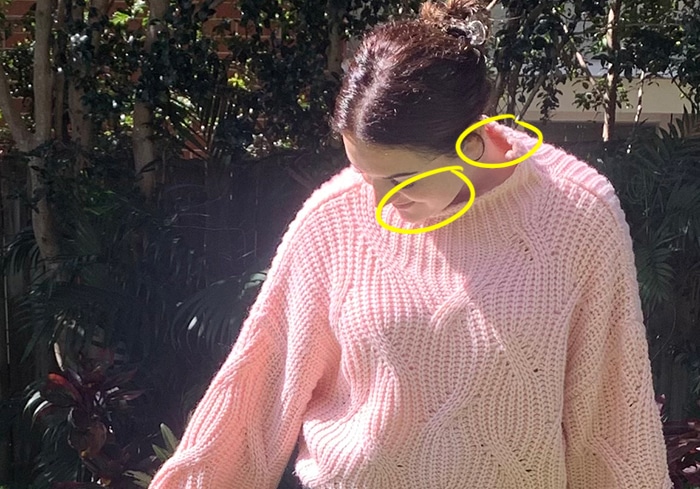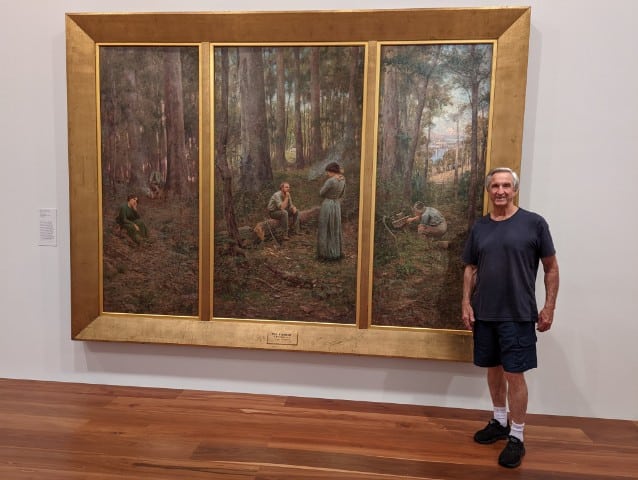A few months ago, I took this beautiful photo of Chontele and Elora. We were at my parents’ house. I was inside having a chat with my mum and dad and Chontele was playing with Elora in the garden. I watched this photo come together through the window. Everything is just right. The light, colors, positioning, the subject, everything.
I plan on doing a large painting based on this photo. So far, I have done a small study in preparation. See below. It turned out to be a charming piece in its own right. This report will cover the challenges and lessons learned from this study.

On Not Taking It Too Seriously
I find that taking a painting too seriously can be detrimental to the outcome. It makes you overthink decisions, it tightens up your arms and hands, and it makes you timid and safe.
I remember this being particularly evident when I painted a commission for a friend many years ago. I stressed and deliberated over every single stroke and decision. And you could tell in the finished painting. It looks like it was painted with timid and uncertain hands. I haven’t painted a commission since.
Painting studies gives you a chance to paint completely free of expectations. You can still try to paint a beautiful artwork, but you don’t demand it from yourself. Wonderful things happen when you do this. Decisions come easier and your strokes become more natural and fluid. Because of this, studies often turn out better than the main piece.
The real challenge is maintaining this mindset and approach even if you know the outcome is serious. Of course, you can be more careful and deliberate than when painting studies, but your hands should be relaxed, your strokes should be confident, and your decisions should be made with both instinct and calculated thought. That’s what I’ll be trying to do when it comes to painting the large version of Chontele and Elora in the Garden.
Reflect Light in the Shadows
The most difficult aspect of the study was painting the reflected light in the shadows. I still haven’t completely figured it out. Reflected light is light that bounces off surfaces and around the environment. When it hits a shadow, it makes some parts of the shadow lighter than other parts. For example, take a look at the following closeup of Chontele. (Sorry to put you in the spotlight Chon!) See how parts of her cheek and neck are lighter yet still part of the shadow. This is from reflected light.

The presence of reflected light makes painting shadows much more complex and nuanced. It means that, not only must you get the big-picture light and shadow relationships right, but also the light and dark relationships WITHIN the shadows. And you must do this without compromising the integrity of the shadows (there must be a clear distinction between areas in shadow and areas in light).
In practice, I paint reflected light in a shadow a touch lighter than the rest of the shadow, but darker than any of the lights. This is harder than it sounds and there’s little room for error. Your eyes will play all kinds of tricks on you, making the colors appear lighter or darker than they really are.
You must also account for the color of the reflected light. I’m not completely sure of the science behind the color of reflected light, but a rudimentary guide is to look at the color of the object reflecting the light. For example, an apple will reflect red light; a banana will reflect yellow light. Below is a closeup of Elora. There are two colors of reflected light that I needed to account for. First, reflected light coming in from the side off Chontele’s jumper. This appears to be a warm, pink light. Second, reflected light coming up off the ground. This appears to be a warm, green-yellow light. To paint this correctly, I needed to capture the subtle changes in color and temperature whilst maintaining a consistent value (lightness). I also needed to account for the interaction between the colored reflected light and the local skin tones of Elora’s face.

Doing Enough but Not Too Much
I also found it difficult to capture the essence of the scene whilst retaining a consistent and painterly style. If I did too much, the study looked overworked and awkward. If I didn’t do enough, it looked unfinished and unrealistic. I needed to capture the look, feel, expression, and essence of Elora and Chontele without painstakingly rendering every little detail.
I felt a natural urge to do too much, particularly with the facial features. I would focus too deeply on these areas and overlook the big-picture. I had to constantly step back and remind myself to simplify.
Tip: Make sure you frequently step back from your painting and view it from a distance and at different angles. This will keep you in touch with the big-picture aspects of the painting. Always be weary of tunnel vision and remember that a painting must work as a whole, not as a collection of parts.
The key was to observe carefully and objectively. What are the shapes, lines, and colors? This is no easy task. It meant I had to see my two beautiful girls not only for who they are and what they mean to me, but also as an arrangement of artistic elements.

I remember hearing some wise words from a master artist (it may have been Jeffrey Watts or Steve Huston, I’m unsure) about how painting a subject comes down to what we know and what we see. The best artists draw on both sources.
The problem I faced when painting Chontele and Elora was that what I know overpowered what I saw. That is, I was prone to painting the preconceived image I have in my head of Chontele and Elora rather than what’s actually there in the reference. I could draw on these feelings and images in my head but observation is also essential.
To capture the slightly joyful expressions on Chontele and Elora’s faces, I focused on capturing their raised and full cheeks and the pinches in their skin around their noises and under their eyes rather than clearly defining their lips. This is an area I’m looking to improve for the main piece, though it should be easier with more room to move (small paintings can be a bit finicky).
Tip: The best answer isn’t always the obvious one. Sometimes the best way to convey a subject’s smile is to focus on their eyes and cheeks.
Getting the Fundamentals Right
If you look up close, you’ll see I simplified most of the detail. I didn’t even paint Chontele and Elora’s eyes or lips. Yet, it appears realistic from afar. This comes down to getting the fundamentals right (or right enough), allowing the viewer to fill in any gaps in detail.
You should spend most of your time and focus in a painting on getting the fundamentals right. That is, focus on the major colors, shapes, forms, values, and relationships. If you get this right, your painting is 80% there. The remaining 20% are the finishing touches, tiny details, nuances, and making sure all the parts work together as a whole.
Beginner painters often get it the wrong way around. They spend most of their time and focus on the tiny details at the expense of the fundamentals. But the tiny details are irrelevant if the fundamentals are wrong. It’s like building a house on sand and then filling it with beautiful ornaments and stained glass windows.
A simple test of a painting’s fundamentals is to look at the painting as a thumbnail (a small image). If it looks realistic, then you likely got the fundamentals right.

Painting the Background
I painted the background first and then worked on Chontele and Elora. I’m more comfortable painting nature than I am painting people. Painting the background first allowed me to build up some confidence and momentum before stepping outside of my comfort zone.


I’m completely satisfied with the way I painted the background and how it turned out. I need to make some adjustments for Chontele and Elora, but no adjustments are needed for the background when I attempt the main piece. Funnily enough, the background is what I spent the least time and effort on. I painted rapidly and was guided almost entirely by instinct plus a few glances at the reference photo. It felt effortless.
It’s terms of its role in the painting, the background provides context and acts as a point of contrast for Chontele and Elora. It’s full of rich color, sharp contrast, and painterly brushwork, whereas Chontele and Elora are conveyed with delicate colors and careful brushwork.
Anyway, that’s it for now. I’ll let you know how the main painting of Chontele and Elora turns out.
Until next time.
Happy painting!

Dan Scott
Draw Paint Academy
PS. My parents recently visited the National Gallery of Victoria. Below is a photo of my dad with Frederick McCubbin’s The Pioneer. I featured this painting in my Composition Breakdown course. I knew it was big, but not that big! And what a frame. Thought you might find it interesting.

